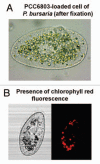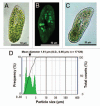Forced symbiosis between Synechocystis spp. PCC 6803 and apo-symbiotic Paramecium bursaria as an experimental model for evolutionary emergence of primitive photosynthetic eukaryotes
- PMID: 21494093
- PMCID: PMC3218470
- DOI: 10.4161/psb.6.6.15239
Forced symbiosis between Synechocystis spp. PCC 6803 and apo-symbiotic Paramecium bursaria as an experimental model for evolutionary emergence of primitive photosynthetic eukaryotes
Abstract
Single-cell green paramecia (Paramecium bursaria) is a swimming vehicle that carries several hundred cells of endo-symbiotic green algae. Here, a novel model for endo-symbiosis, prepared by introducing and maintaining the cells of cyanobacterium (Synechocystis spp. PCC 6803) in the apo-symbiotic cells of P. bursaria is described.
Figures




Similar articles
-
Micro-particle transporting system using galvanotactically stimulated apo-symbiotic cells of Paramecium bursaria.Z Naturforsch C J Biosci. 2009 May-Jun;64(5-6):421-33. doi: 10.1515/znc-2009-5-621. Z Naturforsch C J Biosci. 2009. PMID: 19678550
-
Green paramecia as an evolutionary winner of oxidative symbiosis: a hypothesis and supportive data.Z Naturforsch C J Biosci. 2004 Jul-Aug;59(7-8):538-42. doi: 10.1515/znc-2004-7-816. Z Naturforsch C J Biosci. 2004. PMID: 15813376
-
Flow cytometry as a strategy to study the endosymbiosis of algae in Paramecium bursaria.Cytometry. 2000 Nov 1;41(3):209-15. doi: 10.1002/1097-0320(20001101)41:3<209::aid-cyto8>3.0.co;2-u. Cytometry. 2000. PMID: 11042618
-
Secondary symbiosis between Paramecium and Chlorella cells.Int Rev Cell Mol Biol. 2010;279:33-77. doi: 10.1016/S1937-6448(10)79002-X. Epub 2010 Jan 29. Int Rev Cell Mol Biol. 2010. PMID: 20797676 Review.
-
Symbiosis in Paramecium Bursaria.Symp Soc Exp Biol. 1975;(29):145-73. Symp Soc Exp Biol. 1975. PMID: 785659 Review.
Cited by
-
Method for Stress Assessment of Endosymbiotic Algae in Paramecium bursaria as a Model System for Endosymbiosis.Microorganisms. 2022 Jun 18;10(6):1248. doi: 10.3390/microorganisms10061248. Microorganisms. 2022. PMID: 35744766 Free PMC article.
-
De novo transcriptomes of a mixotrophic and a heterotrophic ciliate from marine plankton.PLoS One. 2014 Jul 1;9(7):e101418. doi: 10.1371/journal.pone.0101418. eCollection 2014. PLoS One. 2014. PMID: 24983246 Free PMC article.
-
Metabolic constraints for a novel symbiosis.R Soc Open Sci. 2016 Mar 23;3(3):150708. doi: 10.1098/rsos.150708. eCollection 2016 Mar. R Soc Open Sci. 2016. PMID: 27069664 Free PMC article.
-
Hidden Allee effect in photosynthetic organisms.Commun Integr Biol. 2020 Aug 30;13(1):119-127. doi: 10.1080/19420889.2020.1800999. Commun Integr Biol. 2020. PMID: 33014264 Free PMC article.
-
Mitigation of copper toxicity by DNA oligomers in green paramecia.Plant Signal Behav. 2015;10(11):e1010919. doi: 10.1080/15592324.2015.1010919. Plant Signal Behav. 2015. PMID: 26418558 Free PMC article.
References
-
- Aonuma M, Kadono T, Kawano T. Inhibition of anodic galvanotaxis of green paramecia by T-type calcium channel inhibitors. Z Naturforsch. 2007;62:93–102. - PubMed
-
- Furukawa S, Karaki C, Kawano T. Micro-particle transporting system using galvanotactically stimulated apo-symbiotic cells of Paramecium bursaria. Z Naturforsch. 2009;64:421–433. - PubMed
-
- Irie K, Furukawa S, Kadono T, Kawano T. A green paramecium strain with abnormal growth of symbiotic algae. Z Naturforsch. 2010;65:681–687. - PubMed
-
- Brown JA, Nielsen PJ. Transfer of photosynthetically produced carbohydrates from endosymbiotic Chlorellae to Paramecium bursaria. J Protozool. 1974;21:569–570. - PubMed
-
- Tanaka M, Miwa I. Significance of photosynthetic products of symbiotic Chlorella to establish the endosymbiosis and to express the mating reactivity rhythm in Paramecium bursaria. Zool Sci. 1996;13:685–692.
MeSH terms
Substances
LinkOut - more resources
Full Text Sources
Miscellaneous
